#they Do overcook it Just A Bit and the texture can be a little tough as a consequence
Explore tagged Tumblr posts
Text
oh my god i need to eat home cooked salmon today. the urge just hit me like im some kind of grizzly bear fresh out of hibernation. i've been holding off on making it myself because of the heat but oh my god. oh my god.
#i am thinking about fresh just Barely underdone salmon fresh out of the oven#that finishes cooking as it comes up to temperature on the pan#with crackly skin and lots of herbs#i got some earlier this week from the fish place nearby but as tasty as it is/was (they put soooo much crushed garlic and vinaigrette on it#they Do overcook it Just A Bit and the texture can be a little tough as a consequence#i want to make it myself so bad i'm going to watch a thing with friends and then i am making a beeline for the supermarket#mio needs salmon its good for their heart and soul
49 notes
·
View notes
Text
MEATBALL TIME
Since @friendly-peep asked how I make them. :3
Original recipe (it's been altered a lot since) I got from my Italian grandma who didn't measure anything so none of this has actual measurements, sorry--I never do either, I just Vibe. Keep in mind pretty much all of this is "to taste" so you can add or remove various ingredients if you know how you like your stuff seasoned.
I've got some notes by the ingredients because multiple of them I use specific preparations for sensory or energy issues due to chronic fatigue and wanting to save myself the energy of prepping certain things.
Ingredients:
Ground Beef (The variety I use specifically is 80% lean, 20% fat.)
Minced garlic (I use the jar stuff mostly, I don't really notice a big difference when using fresh)
Ground sage
Powdered/ground rosemary (You can probably use the needles, I use this for texture sensory issues)
Ground black pepper
Table salt
Crushed dried basil (you can use fresh! I use this for energy and convenience reasons)
Crushed dried marjoram
Bread crumbs (I use a store-bought "Italian seasoned" mix)
Water (original recipe used tomato sauce, but one of my family members has a tomato allergy so I use water instead and it works well)
Garlic powder
Onion powder
Instructions!
Preheat the oven to 350 Fahrenheit/177 Celsius
Grease up some glass cooking pans (you can probably use nonstick cooking sheets instead, I just haven't myself). Depending on the amount you make and the size of your pans/cooking sheets, you may need just one or you may need several.
Get a good-sized bowl to mix everything together in! Always err on the side of larger rather than smaller, it's way easier to avoid mixing issues in an oversized bowl than an undersized one. If making a lot of meat, feel free to split it between more than one bowl or to do it in batches!
Make sure you have all your ingredients to hand--double check before handling the meat!
Start adding all the ingredients to the bowl(s). I personally like to layer down meat, then sprinkle the rest of the dry ingredients in, then layer more meat, more dry ingredients, etc. Once all the meat is in the bowl(s) pour in the water (or tomato sauce).
Adding the fluid is usually the hardest part, you can't have too much or too little. If you're unused to making stuff like this, it might be better to make a few smaller batches where you experiment to get a feel for how much you need. Too much and they'll be mushy, too little and they'll crumble and be hard to work with.
Mix it all up! I do this by hand, do it carefully--it's really easy to overmix and then they get kind of tough. This is where I find bigger bowls are helpful, easier to get it all mixed together. This is also why I find layering the ingredients helps! You get the flavor throughout without having to mix it too much.
Shape the meat into balls! Ideally I kind of try to get them golf-ball sized but they inevitably end up larger. But really it's just kind of preference. Keep in mind the larger they are the longer it will take to cook the inside properly so you might get overcooked outsides and undercooked insides if they're too big.
Place them in the pans. They can be close to each other, even pressing against each other but you don't want them squishing together too much.
Once they're all in, cook for 18-20 minutes, then check. Once you get a feel for them you can usually tell if you'll need to start at 18 or 20 depending on size.
Make sure they're cooked properly inside! If needed, put them back in for a bit. I usually do 2-4 minute increments depending on how obviously undercooked they still are. When in doubt, you can always do less time and just keep putting them back in as needed!
And that's that!
This recipe I also use for meatloaf with no alterations aside from the following steps:
Shape into a loaf
Put some oil on top of it, spread nicely over the whole thing
Cook for 18-20 minutes, then pull out and cut in half, get some oil on the newly opened inner parts
Cook for another 18-20 minutes then check with meat thermometer for correct internal temperature. Cook longer as needed.
You can also just cook it straight for about 30-40 minutes or so, but due to sensory reasons I find that I prefer the texture when I prep it like this.
You can make both the meatballs and some meatloaf from this at the same time, too--I often do because if I'm making a lot then by the end I don't have the pan space for a bunch of meatballs but I can slap a loaf in that space easily!
I'm aware most people use an egg, my grandma never included one so I never did and I've liked the taste and texture well enough I never bothered experimenting with adding any, personally.
6 notes
·
View notes
Text
Season 3 Episode 6: Queen of Puddings
I started watching GBBO at least four years ago, and yet I still do not know what a pudding technically is. Sometimes it seems to just be a catchall term for “dessert”. This VOX article claims that “A British pudding is a dish, savory or sweet, that's cooked by being boiled or steamed in something: a dish, a piece of cloth, or even animal intestine,” which is confusing, because I don’t think I did any of that for this week’s bake. (There were certainly no animal intestines involved.) But whatever a pudding is, this week I made the Queen of Puddings, at least as defined by Mary Berry.
https://www.bbc.co.uk/food/recipes/queen_of_puddings_79904
Step one was to grease a ¼ liter shallow ovenproof dish, which I do not have. Off to a great start! In my defense, there is only so much room for baking equipment in my apartment’s kitchen. I dug this dish up from my parents’ house and went with it because it was oval-shaped, like Mary’s example photo, but it definitely doesn’t qualify as “shallow”.
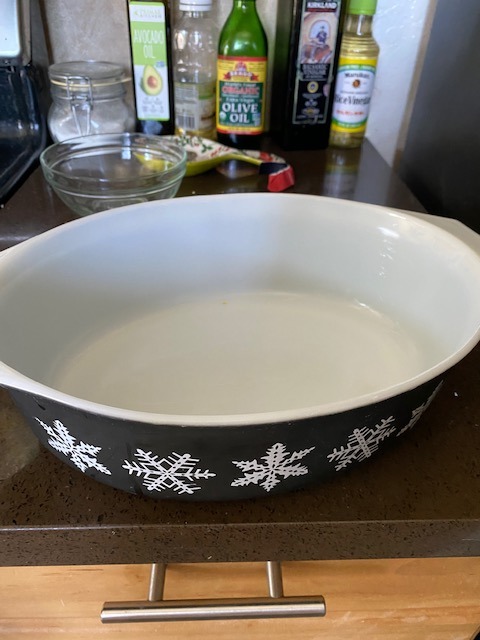
Good enough.
Next up was to make a custard. First, I heated up milk, butter, lemon zest, and sugar in a sauce pan.
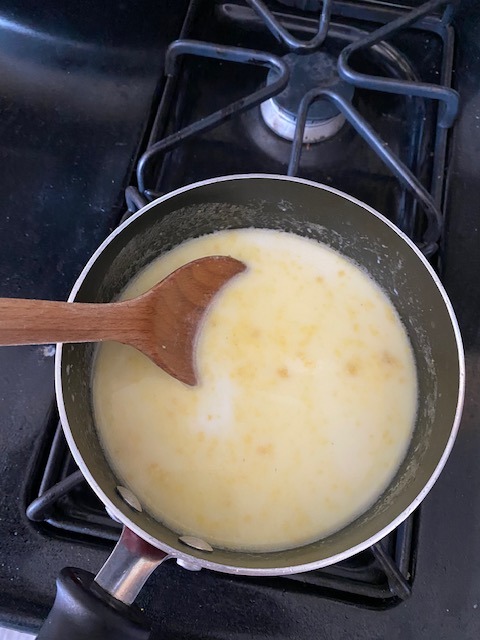
Does this count as “boiling or steaming” something?
Then, I carefully poured my warm egg mixture into a bowl with my egg yolks, which I had already separated from the whites. I whisked it together, and a custard was born.

Custard!
To make this custard more substantial, it is poured over a base of bread crumbs. Mary’s recipe specifies “fresh” bread crumbs, but I did not have a bunch of semi-stale bread lying around, so pre-packaged bread crumbs it is.
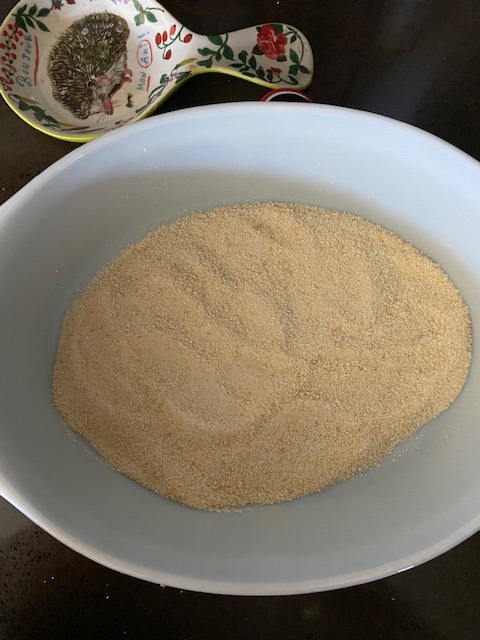
I told myself after my last bake that I’d stick to the recipe moving forward. Clearly that lesson did not sink in.

Crumbs + custard
I put my dish into a roasting tin, filled the tin with water, and stuck the whole thing in the oven.
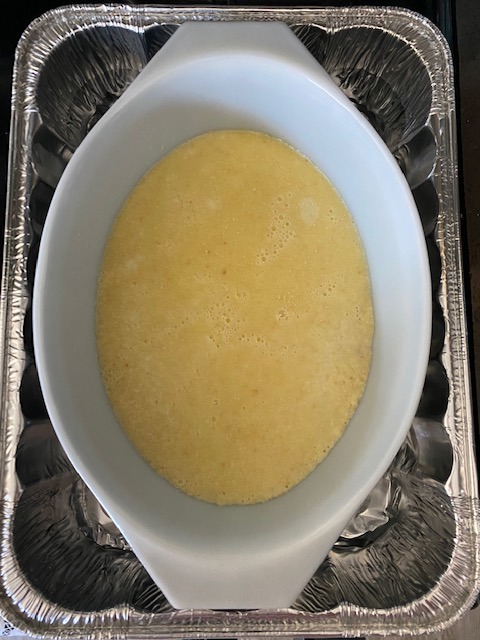
At least my dish fits in the tin.
While my custard baked, I turned my attention to the next element of my bake: jam. Mary’s recipe suggests that you can use store-bought jam if you don’t want to make your own, but I have never made jam before and figured it was one of those things that was bound to come up sooner or later. Plus, I knew the bakers would have to do it, and I wanted to stay in the spirit of the competition. So I gave it a shot.

I used a mixture of raspberries, strawberries, and blackberries, since that’s what I had on hand in my freezer, but it seems any “summer fruit” will do.
I had some trouble getting my frozen berries to fully reduce into a cohesive sauce, and after what felt like ages of cooking time, my jam still seemed a bit watery with big chunks of fruit.
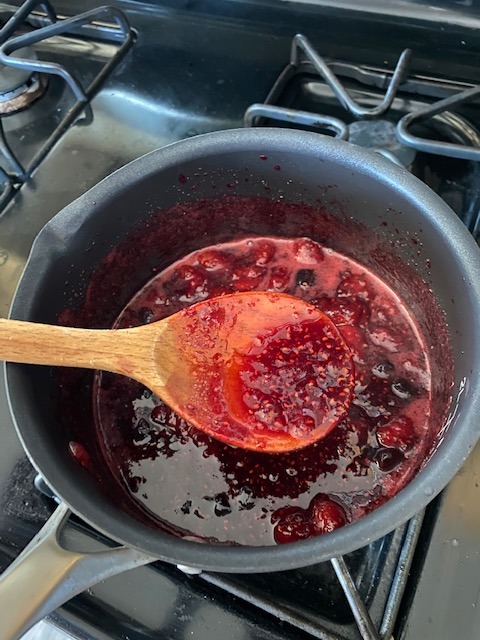
I guess this also counts as “boiling something”…
I decided to run my jam through a strainer, which didn’t help my watery-ness issue one bit, but I managed to mash the bigger pieces of fruit against the strainer to make them more sauce-like, and reincorporated it into the strained juice to produce something that could pass for jam, albeit a very runny one.
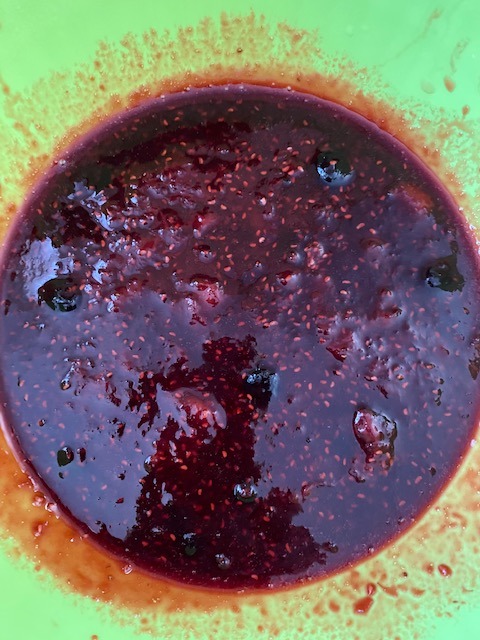
It’s a pretty color, at least.
Meanwhile, it was time to pull my custard out of the oven. I think I overcooked it slightly, but I had trouble getting the custard to set as much as I felt it should.

I baked the custard for about 35 minutes, instead of the 20-30 specified by the recipe.
While my custard cooled, it was time to make meringue. Luckily, I had some egg whites just sitting around that I had to separate from their yolks for the custard earlier. It’s always nice when a recipe doesn’t waste ingredients. Those egg whites and a bit of sugar quickly became meringue.
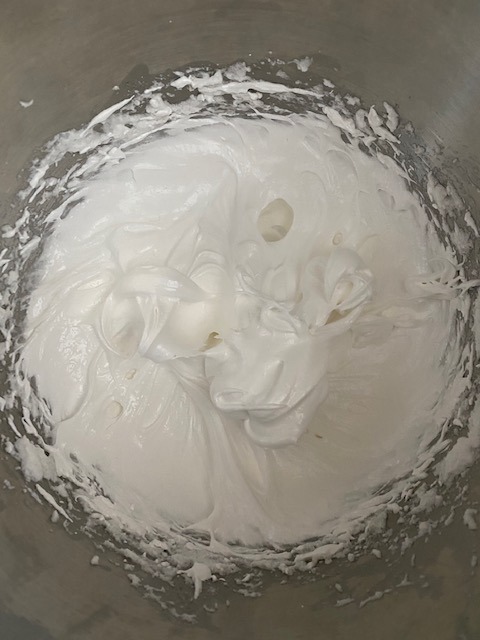
Thanks, KitchenAid stand mixer!
Finally, it was time to assemble. First, I put my jam on top of my custard. I vastly overestimated how solid the custard was and dumped a whole bunch of jam right on top, which caused it to mix in a bit with the custard. I quickly realized that it was better to gently spoon the jam on top of the custard.
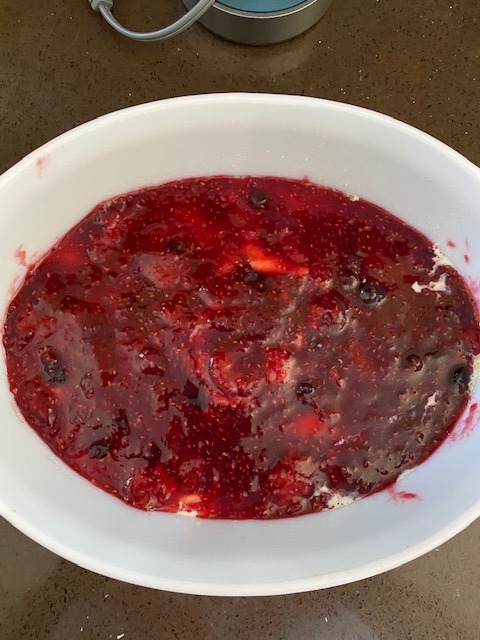
Hopefully didn’t mess up the layers TOO much.
Next, it was time for meringue. I piped little poofs all over the top of the dish.

I’m actually very proud of my piping on this one.
And with that, the whole thing was ready to go back in the oven to brown the meringue. Not too difficult, all said and done. But would the bakers agree?
Sarah-Jane isn’t feeling too confident heading into the technical, as per usual. “You just have to kind of draw on everything you know about… everything… ever… in the space of five minutes,” she says.

I think Sarah-Jane might be my spirit animal.
Ryan has somehow never made custard or jam before, which leads me to question his GBBO preparation techniques.

Even I’ve made custard before!
Mary explains that the Queen of Puddings is many families’ favorite pudding, which I guess presumes that said families eat a variety of puddings on a regular enough basis to choose a favorite.

I’m really hung up on this whole “pudding” thing, I know.
As the bakers prepare their custards, Mel explains that they shouldn’t bake their custards too long or the surface will crack. I’m now thinking back to my own custard, which definitely had some cracks in the top. Whoops!
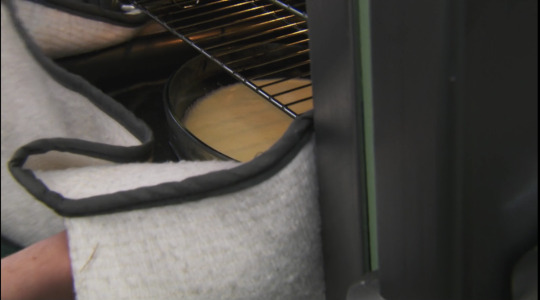
I mean it will be covered in jam and meringue… no one will know.
Next, it’s time to move on to the jam, and Brendan seems to be some kind of jam savant, explaining that he’s looking for a soft-set jam. After all, he says, “There are some advantages to being older… you learn the setting point of jam.”

Showoff.
Like me, John has some problems with the jam running into his custard, although his are much worse.
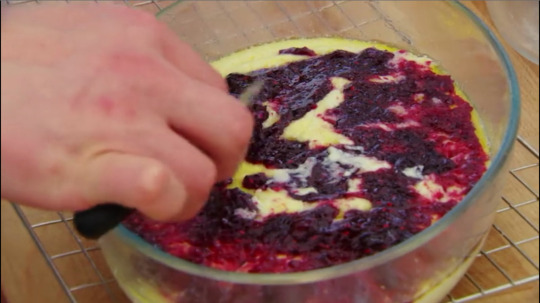
“Mary’s going to slap me in the face,” he moans.
The bakers seem intimidated by the meringue layer, which I find confusing. Meringue just… isn’t that hard?

Here, Danny whips up a second meringue, worried that her first one was too runny.
Finally, all the puddings are in the oven.

Classic GBBO on-the-floor oven-watching pose.
Brendan seems to have gotten a nice golden brown color on the top of his meringue. Will this be the key to a technical challenge win?

Like a perfectly roasted marshmallow.
During the judging, Mary announces that the glass dishes they gave the bakers were part of her evil plan, so she and Paul can see how even the layers are on the puddings.

Feeling grateful for my ceramic dish right about now…
Unfortunately, James has overcooked his custard, which means it came out watery.

Would I fall victim to the same pitfall?
In the end, Brendan’s lifetime of jam knowledge proves useful, and he takes home the win.
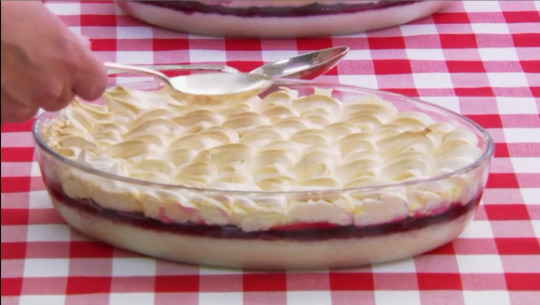
It does look like a rather royal pudding.
My pudding was ready to come out of the oven, but would it be fit for a queen? First, here’s Mary’s example pudding…
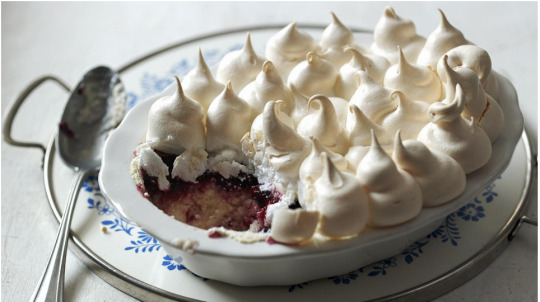
That’s a very elegant shallow dish.
And here’s mine.
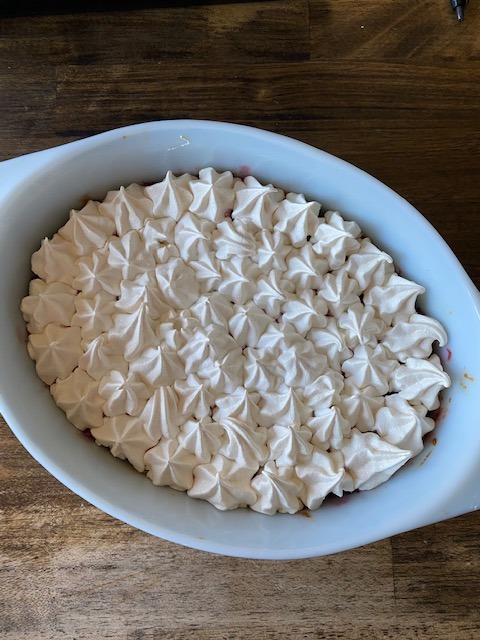
Look at that piping!

The slice admittedly didn’t look too delicious, but there’s a reason Mary’s photo only includes the dish – I just don’t think this one is meant to look pretty on the plate. The show also didn’t really showcase what the bakers’ slices/scoops of pudding looked like. So I’m pretty sure mine is about right. Also, Mary’s recipe said to serve with “pouring cream”, so that’s what the puddle is around the pudding, not melted custard. (The bakers did not seem to do that in the show).
I thought my Queen of Puddings was pretty regal, actually. The meringue had good volume and was nicely crispy, and the jam and custard layers actually held up on the plate. But now it was time to see if my esteemed panel of judges would agree.
***
Matt’s Review: I was actually full from dinner when I dug into this pudding, and I was worried it was going to be too heavy. But as soon as I took my first bite and felt how soft and airy it was, I quickly ate the whole thing. Turned out, that’s a purely mouth-feel thing and I got a horrible stomach ache. But it was worth it. It’s a bread mush with surprisingly complicated flavors—sweetness was potentially the least pronounced one there. The fluffy texture (which I have to assume Jenna nailed) really let you focus on those flavors. It’s a balancing act, and the pudding landed it gracefully. I have no way to fairly judge presentation, but I will add that there’s nothing better than having a Tupperware full of pudding arrive at your door.
Wilson’s Review: Beautiful presentation, clearly defined merengue structure. Some nice peaks, clearly have a steady hand with the piping. But, the color’s a bit light isn’t it? In the future maybe keep it in the oven for a touch longer, or up the heat. Cutting it open you’ve got some nice defined layers, well done. Flavor is good, you can really taste the summer in the jam. The lemon isn’t really coming through, and that’s a key element to balance the sweetness of the jam and the crisp of the meringue – need that acidity. Overall a very good bake, worthy of being served on anyone’s summer table.
***
Final Thoughts: As Matt mentioned, the pudding was delivered to him in the least royal of ways, dumped unceremoniously in a Tupperware and left on his doorstep. So sadly he didn’t get to witness the beauty of my pudding in its original form, and personally, I thought it looked great. I also enjoyed eating it – the meringue was crispy on the outside, soft on the inside, and the custard was smooth and creamy. The jam was definitely a little runnier than a store-bought variety, but I did like it enough to use the leftovers on toast for several breakfasts, so it worked out well enough. And to Wilson’s point, it needed a little more browning on the top of the meringue – perhaps I should have used the broiler at the very end to get that nice golden color. Overall, this was not a particularly tough bake, which was a nice change of pace after trying to get pie dough to defy gravity for the last bake. I still don’t know what a pudding is, but I did enjoy eating it.
50 notes
·
View notes
Note
Can we get Talviel's most hated dishes of each race?
I'm really not a picky eater, but Tamriel is a big place with many strange flavours, and some of them are more unconventional than others! Here's a list of the few foods I simply couldn't handle...don't try them the next time you're out exploring unless you really hate yourself!
Nord
Pickled fish (usually river betty, silverside perch, or slaughterfish) is, for some reason, a cornerstone of the Nord diet. Despite having grown up by Riften Fishery, I have nothing but dislike for the jars of sour, slimy fish that the average Nord gulps down every breakfast. Some variants of pickled fish are also fermented, giving it an extremely pungent odour that has made plenty of outlanders throw up or pass out if the jars are mistakenly opened indoors. Pickled fish is also great for catching skeevers when placed in traps. 1/10
Bosmer
Despite having spent almost a year in Valenwood, there are some aspects of Bosmer cuisine that I may never wrap my head around. Thunderbug soup is one of those things. Thunderbug flesh is grilled over an open flame and seasoned with a bit of salt, then stewed in a large cauldron with a copious amount of thunderbug eggs and sometimes other insects (witchetty grubs, grasshoppers, and large spiders are popular). The end result is a hot, lurid green mess that possibly tastes even worse than it looks, as there is no plant-based seasoning to speak of for obvious reasons, and a lot of antennas and legs poking out in various directions which make for a prickly and generally unpleasant meal. Very nutritious though. 4/10
Orc
Smoked bear paw with harpy innards is a classic stronghold delicacy, and one of the most unpleasant dishes I've ever had to try. The bear paw is so tough and dry that it's basically inedible, and the harpy guts and brains are a chewy and acidic grey mess. The best part is the bread that's used to sop up the harpy bile-based sauce, unless you actually touch the sauce itself. 1/10
Altmer
Honestly there isn't much to dislike about Altmer cuisine, but if I had to choose a dish I'm not mad about, it would probably be heron-liver pâté. Wild herons aren't traditional food birds and their diet of frogs, snails and bottom-feeding fish gives their meat a distinctly muddy flavour and stringy texture. This is especially noticeable in pâté form, even when spiced, and no amount of mashing will compensate for the chewiness of cooked heron livers. 4/10
Redguard
Unless you really enjoy the feel of sand in your mouth, I'd recommend steering clear of Alik'r sand-baked camel. The meat of a camel is covered in spices and salt, and lowered into a hot sand pit in the desert and buried for three weeks to "cook". If the jackals or scorpions haven't gotten to your meal before you do, you're in for a dry, dusty treat! The meat becomes so dessicated that you might as well chew on a Ra-Netu, but it has some great crunch from all the sand. You'll be brushing your teeth for days after eating this just to get the feeling of this monstrosity out of your mouth. 3/10
Argonian
Boiled wamasu and swamp jelly salad sounds exotic, but not too terrible, right? Wrong. Wamasu is an acquired taste, but when cooked right it can be quite tasty. Boiling it is absolutely not the right way to cook it, as it becomes slimy and acidic, and develops a nasty oily sheen. Cut that up into chunks and toss it together with raw swamp jellies, seaweed, bitter swamp grasses, and crickets...and you have the makings for Tamriel's worst stomach ache. Definitely not for anybody but Argonians. 3/10
Dunmer
I'm really very fond of Dunmeri cuisine, but I could quite happily live the rest of my life without ever eating guar wrapped in trama root and scathecraw ever again. First off, I love guars, so eating one was like asking me to eat a dog or cat. It turns out that guar meat is extremely tough and ashy-tasting, so wrapping it in trama root and scathecraw is meant to soften it up as it's cooked over a coal grill. The end result is some acrid, bitter and slightly burned-tasting meat that has the texture of an extremely overcooked steak. I believe that the Ashlanders are extremely wise and interesting mer, but I'm really doubting their commitment to good food after trying this. 4/10
Breton
As much as I love Breton food, it isn't really the sort of cuisine for big flavours and spices. As such, you end up with some pretty bland meals, like sweetbreads in pudding. It turns out that sweetbreads are not sweet, nor are they bread (they are usually lamb pancreas, tongues, and testicles), and the pudding isn't pudding (it's a spongy bread thing). In other words, it wasn't the tasty dessert that a young Talviel on her first trip to High Rock was hoping for, but rather a few soggy pieces of breaded mystery meat served with some bizarre gluten sponge and drowned in flavourless, watery gravy. 4/10
Khajiit
Face it, Khajiiti food is fantastic. Well, that is until I made the mistake of reaching for what I thought was a jar of jam for my flatbread one breakfast. I took a big spoonful of what appeared at first be a sweet and fragrant red chutney, and ended up lying down retching for the rest of the day. It turns out that in Elsweyr, many Khajiit enjoy a moon sugar chutney that's made with flaming hot chilies, herbs, fire ants and ant eggs. The acid from the ants only amplifies the capsaicin from the chilies, and most Khajiit don't use more than a teaspoon, let alone a big dollop. It burns, it stings, and nothing you drink or eat after will put out the fire. Consume at your own risk. 2/10
Imperial
Like Altmer cuisine, I really don't have something I actively dislike with Imperial food. However, I am pretty squeamish about the very upper-class delicacy of fried dormice dipped in honey and stuffed with herbs, cheeses, bacon. Admittedly, they're pretty tasty, but the little feet and faces are absolutely horrible to look at, not to mention the amount of tiny bones you have to spit out. 5/10
#Worldbuilding#Tes#The Elder Scrolls#Food#Fantasy#Argonian#Nord#Dunmer#Bosmer#Khajiit#Redguard#Breton#Imperial#Altmer#Orc
240 notes
·
View notes
Photo

CHIRASHI SUSHI
(From BtN)
https://www.justonecookbook.com/chirashi-sushi/
Ingredients:
FOR PICKLED LOTUS ROOT & GINGER
2 inches lotus root (renkon) (5 cm)
1 inch ginger (2.5 cm)
½ cup rice vinegar (120 ml)
⅓ cup sugar (65 g)
½ tsp kosher/sea salt (use half for table salt)
FOR CHIRASHI SUSHI MIX
4 dried shiitake mushrooms
½ cup water (120 ml) (for soaking dried shiitake mushrooms)
⅔ gobo (burdock root)
0.8 oz dried kanpyo (gourd strips) (20 g)
1 tsp kosher/sea salt (use half for table salt) (for rubbing kanpyo)
½ carrot
1 ¼ cup dashi (300 ml)
¼ cup sake (60 m)
3 Tbsp mirin
1 Tbsp sugar
2 Tbsp soy sauce
FOR EGG CREPE (KINSHI TAMAGO)
3 large eggs
1 Tbsp sugar (optional)
1 Tbsp dashi (or sake or water)
¼ tsp kosher/sea salt (use half for table salt)
½ Tbsp neutral-flavored oil (vegetable, canola, etc)
FOR SNOW PEAS
6 snow peas
pinch kosher/sea salt (use half for table salt)
FOR SUSHI RICE
3 rice cooker cups uncooked Japanese short grain rice (540 ml)
Water
2 inch kombu (dried kelp) (5 cm)
⅓ cup rice vinegar (75 ml)
3 Tbsp sugar
1 ½ tsp kosher/sea salt (use half for table salt)
FOR UNAGI (EELS)
1 package unagi (eel) (160 g)
FOR SHRIMP
8-10 large shrimp
1 Tbsp sake
pinch kosher/sea salt (use half for table salt)
TOPPINGS (OPTIONAL)
4 Tbsp Ikura (salmon roe)
4 Tbsp shredded nori seaweed (kizami nori)
½ Tbsp toasted white sesame seeds
Directions:
TO MAKE PICKLED LOTUS ROOT & GINGER:
Combine rice vinegar, sugar, and kosher salt in a small saucepan. Bring it to boil and let the sugar dissolved completely. Set aside to cool.
Peel and cut the ginger to julienne strips (thinner the better). Peel the lotus root and cut out the edge to make a flower shape
Slice the lotus root into 1/8” (3 mm) and soak in vinegar water for 5 minutes to prevent from turning brown (just drop a few rice vinegar in water – doesn’t have to be precise).
Boil water in a small saucepan and blanch the ginger and lotus root for 3 minutes. Drain well and transfer them to the vinegar mixture to marinate. You can make this ahead and keep it up to 1 week in refrigerator.
TO MAKE CHIRASHI SUSHI MIX:
When the water is boiling cook kanpyo for 3 minutes. Transfer to iced water to stop cooking process and squeeze water out.
Cut kanpyo into small pieces and cut the carrot into julienne strips.
Soak dried shiitake mushrooms with ½ cup water until they are hydrated and tender. Then squeeze the mushrooms and reserve the liquid (= shiitake dashi) in the bowl. Cut off and discard the stem.
Slice the shiitake mushrooms. Strain the reserved shiitake dashi to remove impurities. Save this shiitake dashi until you’re ready to use in Step 8.
Make a criss-cross incision at one end of the gobo. This criss-cross incision will help you shave the gobo like a pencil. Shave into small thin pieces as you rotate the gobo. Soak the cut pieces in water so they won’t turn brown. Change the water 1-2 times. Drain right before you start cooking in Step 8.
In a small saucepan, bring water to boil. Quickly rinse the kanpyo in running water and drain. Rub kanpyo with 1 tsp salt. Rinse and drain well.
Add shiitake mushrooms, gobo, and kanpyo in the pot (keep the carrot aside for now). Add dashi, reserved shiitake dashi (the liquid from hydrating dried shiitake), sake, mirin, sugar, and soy sauce, and bring to simmer on medium heat.
Skim the foam and scum on the surface as much as you can, decrease the heat to simmer, and cover with Otoshibuta (drop lid). This lid ensures that ingredients are submerged under the liquid and flavorful cooking liquid circulates well. You can make one with aluminum foil easily.
Add the carrot while there is still liquid in the pot but toward the end of cooking so that you don’t overcook carrot and get mushy. Continue to cook with Otoshibuta until the liquid is almost gone. The whole cooking process is about 20-25 minutes depending on the heat. Transfer the Chirashi Sushi Mix to a plate to cool completely. If you end up with some cooking liquid, you can save a little bit so you can season the rice later. You can make this ahead and keep it in the refrigerator up to 3-4 days.
TO MAKE EGG CREPES:
Heat the large non-stick frying pan and grease the pan with paper towel dipped in vegetable oil. Make sure to wipe off the excess oil. When the pan is hot, pour the egg mixture just enough to cover the bottom of the entire fry pan.
Gather all the ingredients.
Whisk the eggs and add the rest of ingredients into the bowl. Whisk to combine and strain the egg mixture to get silky texture.
Tilt the pan to fill the fry pan with the egg mixture and cover with the lid. Remove from the heat and place the pan on a cold towel to cool the pan so the the egg won’t become brown. Once the egg crepe is cooked through, transfer to a wire rack and let cool completely. Continue this process until all the egg mixture is gone.
Roll up the egg crepes and cut thinly into julienned strips. Loosen them up and set aside. You can make this ahead and keep it in the refrigerator up to 2-3 days or freeze up to 4 weeks.
TO PREPARE SNOW PEAS:
Remove the tough strings along the edges of snow peas. Bring water to boil in a small saucepan. Add pinch of salt and blanch them for 2 minutes. Drain and cut diagonally in half or thirds.
TO MAKE SUSHI RICE:
Rinse the rice, soak for 30 minutes, and drain. Put the rice in a rice cooker bowl and add the water till “Sushi” water level (a bit less than regular). Place kombu on top and start cooking. Combine the sushi vinegar ingredients in a bowl and mix together. You can microwave or heat the mixture in a saucepan over the stove to dissolve the sugar completely and remove the strong vinegar taste/smell.
TO PREPARE UNAGI
Preheat your oven to 400F (200C). As the unagi you purchased is already grilled/broiled, all you need to do is reheat. Place the unagi on a parchment paper or silicone baking sheet and bake for 7-10 minutes. Remove from the oven and let cool. Once it’s cool to touch, you can cut into ¼ inch (0.6 mm) pieces. Set aside.
TO PREPARE SHRIMP:
Using a skewer, devein shrimp without removing shell. We peel the shell after cooking to retain the flavor of the shrimp. Boil water in a medium saucepan. Once boiling, add sake and shrimp and simmer until pink, about 2-3 minutes. Remove the shell and set aside.
4) TO ASSEMBLE CHIRASHI SUSHI:
Start this step when all the steps above are completed.
Discard the kombu from sushi rice and transfer to Hangiri (or a large serving platter). If you use hangiri, quickly run water so rice doesn’t stick. Pour sushi vinegar over the rice paddle to evenly distribute sushi vinegar over rice. With the rice paddle, slice the rice at a 45 degree angle to separate the rice instead of mixing. At the same time you need to use a fan to cool rice so the rice will shine and doesn’t get mushy.
Gather all the toppings you’ve prepared.
Once the sushi rice is cooled, squeeze the Chirashi Sushi Mix to remove excess liquid (otherwise rice gets too soggy) and combine with sushi rice. You can always add a few Tbsp of reserved liquid to season the rice if you like (I don’t usually do it).
First, spread the shredded egg crepe. Decorate the chirashi sushi as you like. I usually start from lotus root, shrimp, unagi, snow peas, ikura, sesame seeds, and nori in the center. Enjoy!
#food#recipe#sushi#harvest moon#story of seasons#sos#hm#recipes#chirashi sushi#hm cookbook#harvest moon cookbook#main dish#ginger#vinegar#mushroom#carrot#sake#mirin#soy sauce#egg#peas#rice#seafood#shrimp#fish#nori
10 notes
·
View notes
Text
Happy Birthday, luminescentlily
May 23-Victor Creed/Darcy Lewis super fluffy! Where Darcy is pregnant with their first child and is cravings something but can’t figure out what. Victor then goes out and brings back a dead deer, which at first freaks Darcy and the other avengers out, but then Victor gives her a bite of it to eat and she realizes it’s exactly what she was craving, making Victor very happy that he’s providing for his mate and cub., for @luminescentlily
Written by @ozhawkauthor
… I couldn’t quite make myself write a pregnant woman eating raw meat. Sorry. This is as close as you get.
“It’s… actually really good,” Jane said, her tone surprised.
Darcy eyed the piece of steak Jane was cutting into. “I’ve never tried venison.”
“I gotta admit I didn’t think Victor was going to carry in a dead deer nearly as big as he is when he said he’d handle getting the meat for the barbecue,” Jane admitted, cutting another piece, “but it really is good.”
“We wouldn’t try to poison you. Honestly.” Logan grinned down at Darcy as he set a plate down in front of her, with the piece of well-done steak she’d requested on it. “Victor’s so happy he gets to be provider for his mate and cub, even if you don’t like it, please pretend you do?”
“Did you seriously just say mate and cub?” Darcy riposted. “And since when did you care about Victor’s feelings?”
“Since you convinced him our cookies are better than the dark side’s.” Logan took his seat beside Jane, slung an arm along the back of her chair and started playing with the ends of her hair. “Also, since Jane told me to.”
“Note he’s not commenting on the mate and cub thing,” Jane pointed out.
“Eh, I’ll give him a pass. I feel like that probably came from Victor anyway.” Reaching for the salad, Darcy piled some on her plate. Victor came to join them just as she was picking up her knife and fork, plonking a plate down in front of Logan with a steak so rare it was practically still mooing, or whatever it was deer did. Another one for himself followed. Darcy eyed it, amused. The steaks were so big they were literally overhanging the edges of the plate.
“Are you going to take some salad and pretend like you’re not a complete carnivore?” she asked.
“I am a carnivore, my love.” Victor leaned over to kiss her, flashing his fangs with a wicked grin. “Now eat up.” A warm hand covered her swollen stomach in a tender caress. “You need to keep your strength up.”
At least he hadn’t said she was eating for two, Darcy mused as she cut a sliver of meat off her steak and popped it in her mouth, chewing thoughtfully. He’d learned better.
The flavor wasn’t too bad, she supposed, but damn, that was hella tough. She chewed and chewed, thinking she’d have more luck chewing on a strip of shoe leather.
“Drinks, Victor!” Logan said suddenly, and Darcy caught his wink as he got to his feet. “We forgot the drinks!”
Blessing her brother-in-law silently, she discreetly spat out the tough piece of meat as he and Victor headed back inside and hastily lobbed it into the lake they were picnicking beside, grateful she had somewhere convenient to dispose of the evidence and there wouldn’t be an inconvenient piece of meat for Victor’s over-sensitive nose to find. The rest of her steak quickly followed.
“Not a word,” Darcy warned a giggling Jane.
“Wouldn’t dream of it. You just going to fill up on salad?”
“I’ll be fine.” Darcy looked down at her plate, hiding a grimace. Vegetables seemed to have completely lost their taste, in the last few weeks.
“Shame you can’t stomach it. Really is very good,” Jane said around another mouthful of venison.
“Tasted all right, it was the texture. Like old shoe leather.” Darcy sighed and poked at her salad with a fork unenthusiastically. Victor’s juicy steak, overhanging the edge of his plate and darm near dripping juice onto hers, caught her eye. “It was dry. Maybe Victor overcooked it too much. I mean, that one looks a lot more appetizing.”
“He’d hardly notice if you pinched a bit,” Jane pointed out. “And if he did, he certainly wouldn’t begrudge it.”
Which was completely true. Darcy prodded Victor’s steak with her knife experimentally, watching the pinkish juices flow.
“I might give it a try.” Just one bite, she thought.
Jane’s eyes were very wide, Darcy noticed a couple of minutes later, and the astrophysicist was actually leaning away from her slightly.
“What?” Darcy asked around a mouthful of meat.
“Nothing,” Jane said hastily. “Nothing at all. I mean. Would you like some more? I’m sure Logan wouldn’t mind.” She pushed Logan’s plate across the table towards Darcy.
Darcy blinked and looked down. Victor’s plate was empty apart from some of the meat juices pooled in the center. “Did I eat all that?” she said, startled.
“Apparently,” Victor’s deep voice said, and then he leaned across, grabbed Logan’s plate and put it in front of Darcy. “And you can have all of this too, if you want it. Logan, go put some more steak on the grill.”
“I really don’t think…” but damn, that steak did look good. Darcy reached out to jab in her fork. “Maybe just a little more.”
Victor’s grin was joyous, proud and very sharp. “Eat as much as you want, my love.” Bending down to kiss her, he laid one huge hand gently over her stomach. “It’s gotta be hard work, carrying my cub. I’m gonna make sure you’re well-fed. Even if I have to bring back a deer every day.”
53 notes
·
View notes
Text
Skilled Suggestions And Tips To Much better Cooking
Learning how to cook is like learning how to dance. It normally takes lots of examine, tough work and dedication. The ideas we have set collectively in this post must support you figure out the sorts of things you must concentrate on mastering in buy to turn into the cook dinner you've got often wanted to be. When you are chopping herbs before your meal, a idea that you can adhere to is to toss a minor little bit of salt on the chopping board. This will give you further friction so that you can maximize your cuts. Good quality cuts of herbs will lead to a wonderful food when every thing is total. If you would like to have crispy French fries, then you should soak the potatoes in great water for 30 minutes and then fry them. When potatoes are allowed to soak up cold h2o, the texture is in a position to withstand the excessive warmth of cooking with out breaking down and turning into mushy. When you are going to the keep, do not constantly have a big purchasing list which can restrain you to just getting specified products. See what you like and what you are in the temper for and obtain primarily based on that. This will give you the spontaneity to cook dinner whatever you pick. Rooster broth must be employed when you are sautéing your veggies. Rooster broth can be purchased at any grocery shop. It is important to choose a rooster broth that is lower in sodium so that you do not eat way too a lot sodium. Sodium can trigger you to keep water which is not excellent. When cooking oil cook dinner veggies, attempt employing some chicken broth! Rooster broth provides flavor to veggies and stops them from obtaining caught to the base of the pan. Rooster broth is commonly offered at most grocery retailers, and it is extremely affordably priced. One crucial tip to remember focuses on who you prepare dinner for cooking oil supplier than what to prepare dinner. If you are cooking for your boss, a date, or a person genuinely essential, attempt to refrain from testing out new recipes and new ingredients. You ought to refrain due to the fact you have not experienced a opportunity to check and best the recipe, which may possibly result in cooking problems and unexpected benefits. If you determine to make a roast, leave the bone in if you are in a hurry. You will have a more quickly cooking time because the bone will transfer the heat. Soon after the roast is cooked, just slice all around the bone to serve. To make the excellent pasta, prepare dinner it one particular moment considerably less than what you read through on the box and prepare dinner it the relaxation of the way with the sauce you are serving with it. This assures that you do not overcook the pasta if you have been to toss it in with the sauce soon after you cooked the pasta until it was accomplished in the pot of h2o. When you are cooking pasta, use a reasonable amount of salt in the h2o. This is the most effective time to time pasta. Salting the pasta after cooking it does not permit it to maintain seasoning that effectively. If you are a single of individuals men and women that does not take in a lot of greens so the fresh veggies you get go negative extremely fast you need to purchase frozen vegetables. Frozen vegetables are flash frozen so they are the identical as taking in fresh veggies and you only have to just take as considerably as you need to have from the package deal and return the relaxation to the freezer. To make perfect deviled eggs, make sure the yolk is evenly centered inside of the egg by spinning the egg on a flat area ahead of boiling. Spot an egg, lengthwise, on the leading of the kitchen counter and gently spin it a pair of occasions. The spinning action aids center the yolk inside of the shell. cooking oil will help develop completely-fashioned deviled eggs. Check out your meatloaf or meatballs by examination cooking a small piece. You want your meat to style excellent, so when you make a mini hamburger patty, and fry it up to style it, you can decide if the seasoning is just right or if you require to insert more flavor. Carrying out this makes certain your meatloaves and meatballs are excellent when you pop them out of the oven. Make investments in a great roll of parchment paper. When you are baking, line your pans with it and you will save yourself a lot time and mess. The baked items slide proper off of the paper and all your pan demands is a simple rinse in some hot soapy water! When it arrives to cooking, attempt to deal with your time by cooking several foods at 1 time. This is important because not only will it conserve you income by getting a pre-cooked food but it will also preserve you from having to devote the time cooking it later on on in the 7 days. If a dish calls for thinly sliced meats (like some Chinese dishes, for case in point), freeze the meat before slicing. This helps make it keep its shape far better when you are slicing, which enables the knife to lower by means of with a cleaner line. When meat is thawed out, you typically have to use a sawing movement to reduce the beef, which can make your strains uneven and jagged. When you are cooking rice make certain that you comply with the instructions to the tee! It is greatest when you are cooking the rice to put all of the components in the pot and use the timer! Do not open up the pot till your time is up! You will have the ideal rice. For a a lot more flavorful fried fish coating, substitute the typical crackers with your favourite kind of chips. Salt and vinegar chips crush up just as wonderful as crackers even though including more depth to the closing flavor of fish. You can also change the normal milk dip with dressing for an additional pop of unexpected taste. Just like a dance, you are never ever completed with studying how to cook. There is usually a new style for you to research and master. Just take these ideas and understand to include them into your each day cooking. Constantly bear in mind that you are never done finding out about the artwork of cooking.
1 note
·
View note
Text
Read More 17 Common Mistakes When Making Burgers
The following post 17 Common Mistakes When Making Burgers is republished from Eat This Not That by April Benshosan
You’ve invested in a shiny new barbecue and even tackled the weed jungle that accumulated in the backyard. Grilling season is here, and now that you’ve got the perfect setting to flip patties for friends and family, all you need to do is master the classic hamburger.
Seems easier than spraying weed killer until your thumb goes numb, right? While many folks don’t put much thought into crafting homemade patties, there’s more to it than grabbing ground beef and a package of buns. Below, we’ve rounded up six common mistakes people make when cooking burgers. And we’re not gonna leave you in the dark: you’ll also find easy solutions to all your grilling woes. Read on to discover how to build a better burger, and then don’t forget to throw these 43 Best Foods for Fiber on the grill to round out your meal while you’re at it.
1
Your patties aren’t flat.
Shutterstock
Mistake: “Ever had burger patties that were rounded and not flat? These types of burgers are awkward to eat! People tend to forget that flattening your patty before cooking is essential to making that perfect burger form,” Derek Wolf, fire cooking enthusiast and owner of Over the Fire Cooking, reminds us.
Solution: “Flatten the patties by pressing them flat using a burger press. If you don’t have a burger press, then try pressing together two plates or two cutting boards to get that flat burger form. Fun tip: If you are looking to double stack burgers, make sure to have thin patties or else you will have a very tall burger!”
2
You seasoned the beef too early.
Shutterstock
Mistake: “Ever had a burger that was tough and dry? You might have thought this was because you cooked it too long, but I bet it was because you seasoned it too early,” Wolf says.
Solution: “When seasoning the meat, make sure to form the patty before you add Morton Coarse Kosher Salt and black pepper. Salt extracts the moisture from the meat and leaves you with a dry patty. Adding the salt right before you cook can help guarantee you have a nice, juicy burger that is full of flavor.”
3
Your grill isn’t clean.
Shutterstock
Mistake: “Nothing is worse than burgers sticking to the grill grate when you try to flip them. Most people think that burgers are so juicy that they will release from the grill very easily. This is not always the case,” Wolf tells us.
Solution: “Make sure to clean your grill grate before cooking. Preheat the grill so that the heat loosens some of the previous residues. Take a grill scraper and brush off as much as possible. If the grate is really dirty, then add some oil to the brush and put it onto the grill grate (be careful with oil and fire!). Fun tip: Clean your grill immediately after cooking while it is still hot so that you are ready to start cooking at your next backyard grill out!”
4
You rely only on the grill.
Shutterstock
Mistake: Another error folks are guilty of is thinking they can’t use a pan to make the perfect burger, Claudia Sidoti, head chef & recipe developer at HelloFresh, tells us.
Solution: “Burgers are simple to make on a stovetop, too—with the right seasonings and toppings. A little seasoning can go a long way to bring out the best flavors. Drizzle olive oil into a frying pan on high heat,” Sidoti says, adding that a cast iron is your best bet. “Once it gets nice and hot, and the heat is distributed evenly, it’ll deliver on those grill marks you’re hoping for.” While the cast iron warms up, form the burger patties using your favorite type of meat and then sprinkle on both sides with salt, pepper, and oregano, Sidoti says.
5
You forgot the thermometer.
Shutterstock
Mistake: “If you’re a newbie at cooking burgers, it may be difficult to know when the burger reaches the right internal temperature for your desired doneness,” Sidoti warns.
Solution: To help clear up the confusion, Sidoti recommends using a meat thermometer to check for the desired doneness. An internal temperature of 125ºF denotes rare while 130ºF will render a medium-rare burger. Prefer your meat more done? For medium, cook until the meat reaches 140ºF; for medium-well, aim for 150ºF; and for well-done, leave the patty on the grill or pan until it reaches 165ºF.
6
You flipped the patty too early.
Shutterstock
Mistake: Sidoti tells us that one of the most common mistakes people make when cooking burgers is flipping the patty too early or pressing down on the burger while it’s cooking.
Solution: “Stay hands-off!” Sidoti advises. “Let the meat do its thing and cook and then rest for a minute or two when it’s done!”
7
You flip your patty too many times.
Shutterstock
Mistake: Chef Tamra Scroggins, director of food culture at Sizzler, advises against flipping your burger too much while it’s cooking. “Resist the urge to flip or poke and prod at your patty as it cooks,” says Scroggins. “Doing so can remove the moisture from the meat.”
Solution: “At most, you should cook your burger for at least 3-4 minutes on each side, depending on the doneness you’re aiming for,” she says. “Of course, it’s always best to use a meat thermometer to check the internal temperature of your burgers.” (Refer back to tip #5!)
RELATED: The easy way to make healthier comfort foods.
8
You put the burger on the grill too early.
Shutterstock
Mistake: “Ever have a burger that is overcooked on the outside but not right in the inside?” asks executive chef and concept creator of Shore Club South Beach’s eatery Diez y Seis, chef Jose Icardi. “In that case, you may have put your patty on the grill before it was readily hot.”
Solution: “One of the biggest mistakes people make is putting the patty on the grill before it’s reached the right temperature. Just because the fire is going, doesn’t mean the grill is ready to use for cooking. You want to make sure the grill or pan is hot before throwing on the patty, and then, of course, let it cook before flipping,” he says. And speaking of getting the grill hot…
9
You use lighter fluid to start the fire.
Shutterstock
Mistake: “Have you ever had a burger that hinted at a taste of lighter fluid? You probably used too much lighter fluid to start the fire and rushed to get the fire started,” says Icardi.
Solution: “Invest in good charcoal. Lighter fluid does a great job at starting a fire, but it can majorly ruin the taste of your food. Start up your grill with plenty of time to ensure that you get the perfect fire going without having to utilize any additives,” he says.
10
You stack your burger with too many ingredients.
Shutterstock
Mistake: All too often people top their burgers with just too many toppings, at which point, you begin to taste a plethora of different flavors. Corporate Executive chef for INK Entertainment USA, Patrick Ochs, says achieving that perfect burger to topping ratio is a key aspect in the burger-making process.
Solution: “Balance is key to any burger. Based on whichever condiments, produce, and meat you decide to put in your burger, you must remember to keep a balanced ratio of all ingredients. I tend to make my burgers with the following ratio: 50 percent Bun, 30 percent patty, 10 percent produce, 5 percent cheese, 5 percent sauce. Burgers are meant to be simple and fresh. You want to be able to taste all of your ingredients in every bite,” says Ochs.
11
You over-season your burger.
Shutterstock
Mistake: “Ever try a burger and couldn’t taste the actual quality of the meat? You may have tried too hard to impress your guests,” says Icardi.
Solution: “Keep it simple. Buy good quality meat, and try to go straight from the store to the grill. Freezing the meat may take away from its natural flavors. A little salt and olive oil can go a long way,” he says. Do you hear that? You can ditch that tray of seasoning!
12
You scorch your patties.
Shutterstock
Mistake: Danny Lee, the executive chef of Burger & Lobster USA, says the worst thing you can do is let your burgers flame up. “It looks good on TV commercials, but it makes whatever you’re cooking taste like gasoline,” he explains. “What people confuse this with is the process of flambé, where you’re cooking off the alcohol of wine [and] brandy. What is actually happening is that the fat is touching the flames and burning up, leaving a residue that tastes like gasoline.”
Solution: “I understand it is difficult to control this on grills due to the amount of fat in burger patties, so I would recommend moving the patties away from the flames to a different spot on the grill. Otherwise, the other option would be to cook the burgers on a griddle, which helps it cook a bit in its own fat,” he says.
13
You’re not using the right kind of grind or cut of beef.
Shutterstock
Mistake: “Too fine or too coarse of a grind on your patty and using the wrong cut of beef can also ruin a burger,” says chef de cuisine at Wolfgang Puck Bar & Grill in Downtown Summerlin, Las Vegas Daniel Stramm.
Solution: “When making burgers fresh you want to make sure that your grind is just right. If you have too coarse or too fine of a grind, it will take away from the texture of the burger. Also, the cut of meat that you decide to use can play a huge role in your burger texture. I like to use a blend of chuck, brisket, and chain meat from tenderloins. If your meat is too lean your burger will be dry. If your meat is too fatty your burger will fall apart,” says Stramm.
14
You neglected to pick the right bun.
Shutterstock
Mistake: “Many people forget that the bun is just important as the meat,” says Ochs.
Solution: “Just like all the other ingredients when constructing a burger, the bun is the main piece to the puzzle, which holds it all together. There are many types of buns such as classic, brioche, wheat, potato, and lettuce. Based on your preference, you can then decide on how to build your burger patty. I personally prefer to use a potato roll, which is light and soft, making it the perfect combination to enjoy all the flavors of the burger itself. Remember to also toast the bread to add a layer of flavor and complexity,” he says.
15
You squish your burgers to cook faster.
Shutterstock
Mistake: You may feel like pressing down on your burger will expedite how fast it will cook, however, chef Stramm warns against it. “This lets all of the flavor you developed through seasoning drip right down into your coals, causing a spark, which in return will put a carbon taste into your burger,” he says.
Solution: “Let your burger take time to cook and develop stronger flavor through the Maillard reaction, he says. The chef says this kind of reaction is a chemical one that occurs between an amino acid and a reducing sugar once heat is applied. He says it has a similar effect as caramelization.
16
You cook too many burgers all at once.
Shutterstock
Mistake: If you’re hosting a party or cookout, you may feel the need to whip up all of the burgers at once, but Executive chef Linh Aven of B.GOOD says to reconsider so you don’t sacrifice the taste.
“It can be tempting to cook a whole bunch of burgers at once to avoid being stuck standing at the grill while everyone else is socializing, but spending a few extra minutes at the grill to cook your burgers to order is well worth it.”
Solution: Make sure to prep everything else beforehand so that way you can spend time flipping the burgers.
“Burgers are best eaten right away,” she says. “You don’t want to compromise on taste when you’re feeding a group of guests, and nobody wants a cold burger wrapped in foil! That said, you can minimize the amount of additional work needed by prepping everything else like condiments, toppings, [and] plateware in advance.”
17
You don’t let your patty rest.
Shutterstock
Mistake: Culinary Director at King’s Fish House, Fabrice Poigin, and chef Ochs both say that one of the biggest mistakes you can make while making burgers is not giving it adequate time to rest on the grill. Have you ever bit into a hamburger and thought the bun was just too soggy? It’s likely that you’re just eating your burger too quickly after it finished cooking. Here’s how to avoid that.
Solution: “Allow the beef patty to rest at least a couple of minutes after cooking, some blood and juices will drip away thus keeping the bun from getting soggy,” says Poigin.
“Resting is very important when cooking a burger. Like most meats, giving your burger the chance to rest allows all of the deliciously mouthwatering juices to collect and re-distribute throughout the patty, for a real concentrated juicy flavor,” says Ochs. “The smaller the burger patty is, the less time that’s needed to rest. For larger patties, you should allow the burger to rest for up to 6-10 minutes.”
The post 17 Common Mistakes When Making Burgers appeared first on Eat This Not That.
0 notes
Link
How to Cook Brussels Sprouts Dr. Mercola Brussels sprouts are probably one of the top vegetables that often get a bad rep, and are often disliked by many children and adults. But this nutrient-dense food is often misunderstood — and improperly cooked — which is why their delicious flavor isn’t always maximized. A member of the Brassica family, along with broccoli, kale and cauliflower, Brussels sprouts look like small, cabbage-like buds that grow on a large stalk. This plant was cultivated in Italy during the Roman emperors’ reigns, and was named after the city of Brussels, Belgium. The cultivation and consumption of this vegetable has been referenced since the 1200s. The thing about Brussels sprouts is that they can be tricky to cook. Leave them on the stove for too long, and they will turnmushy, overly smelly and will lose their bright green color — a sign that they’re overcooked, making them unappetizing. However, if properly cooked, these vegetables will have a bright green color, a pleasant, nutty-sweet flavor and a mildly crisp texture. How to Cook Brussels Sprouts: Prep Them Properly First Whether you’re making pan roasted, baked, sautéed, grilled, fried or steamed Brussels sprouts, there are three important preparation steps you need to follow: washing, trimming and cutting. Here are some basic steps to get you started. , Wash the Brussels sprouts using lukewarm water, either by running them under the tap or submerging them in water in a bowl for 10 minutes. Remember to use lukewarm water specifically, as it is better in removing dirt and chemicals than cold water. While the first one is faster, the second method actually cleans them better, dislodging dirt and chemicals both on the exterior and in the inner folds of the leaves. You can also add baking soda to help clean Brussels sprouts more thoroughly. This is crucial if you’re working with conventionally produced vegetables, as baking soda has been found to help remove pesticides better than just water. According to one study, baking soda can remove as much as 96 percent of toxic pesticides that contaminate most produce, such as the fungicide thiabendazole and the insecticide phosmet. The researchers used a concentration of about a teaspoon of baking soda for every two cups of water, which they deemed an effective ratio, and used it to gently scrub the produce for 12 to 15 minutes. The only disadvantage with soaking them is that the Brussels sprouts can become waterlogged. If you're going to sauté, grill or roast them, you have to allow them to dry first. Using a ceramic knife, trim a little bit of the tough stem off, which will make the vegetable more tender. Remember not to remove too much, no more than an eighth of an inch, or the leaves will fall apart while cooking. Afterward, remove any brown or yellow leaves, as they’re already wilted. Cut an X shape into the top of the sprouts if cooking them whole. This is because the outer leaves cook faster, and by the time the center is cooked, they will already be mushy and overcooked. By carving an X into the sprouts, they will cook more thoroughly. If cutting into smaller pieces, make sure that they’re all the same size so they will cook evenly. The website Enjoy How to Cook recommends Brussels sprouts with diameters bigger than 1 1/2 inches to be cut in half. If you have a variety of sizes, bigger ones should be cut in quarters and medium sprouts in half. Once you’re done prepping, you can now try any of these methods to cook the sprouts. The sweet, delicate flavor of Brussels sprouts pairs well with bacon, beef and other meats, making them a delicious side dish. Each cooking method has its own advantage and disadvantages, so select the one that best suits your preference. How to Cook Brussels Sprouts on the Stove: 3 Methods You Can Try There are three ways to cook Brussels sprouts atop your stove: You can either sauté or fry them in a pan, boil them in a pot or steam them. Check out the differences between these methods: How to Cook Brussels Sprouts in a Pan Cooking Brussels sprouts in the pan not only retains their beneficial compounds better than steaming or boiling, but they also don’t get too overcooked and they won’t have a strong smell. Plus, it also lets them caramelize, bringing out their delicately sweet and nutty flavor. Here’s how to cook Brussels sprouts in the pan: Ingredients: 1/2 pounds Brussels sprouts, trimmed and halved lengthwise 1 1/2 tablespoons raw butter 1 tablespoon Dr. Mercola’s coconut oil 2 tablespoons pine nuts 2 large garlic cloves, thinly sliced Salt and pepper, to taste Procedure: Melt a tablespoon of butter in a pan with the coconut oil, over moderate heat. Add garlic and cook until pale golden. Transfer to a small bowl. Reduce heat to low and arrange the sprouts in the pan, cut sides down, in one layer. Sprinkle with salt to taste. Let cook, without turning, for about 15 minutes or until the undersides are golden brown and crisp tender. Transfer sprouts to a plate, browned sides up. Add more garlic and remaining 1/2 tablespoon butter to the pan and let cook over moderate heat, stirring, until the nuts are more evenly pale golden, about 1 minute. Spoon this mixture over sprouts and sprinkle with pepper. As a side dish, this recipe makes two to three servings. How to Boil Brussels Sprouts Take note that boiling Brussels sprouts can cause some of their flavor to leech out. However, if you’re after a mild-tasting dish, then this would be perfect for you. Here’s how to do it. Ingredients: 1 quart Brussels sprouts, washed and prepped 1 1/2 cups water 1 teaspoon salt 1/4 teaspoon pepper 2 tablespoons raw butter Pepper, to taste Procedure: Place the sprouts, salt and water in a saucepan, until completely submerged. Add more water if needed. Cover the pan and boil sprouts gently, for 15 to 20 minutes, or until crisp tender. Drain and season with butter pepper. Serve while hot. How to Steam Brussels Sprouts Steaming is a good way to cook Brussels sprouts, especially if you don’t want to use oil or butter. It makes them tender but not overcooked, and they do not end up waterlogged or soggy. You can use a steam basket or just place the vegetables in the pan. Direct Steaming Method: Fill the pan with a half-inch of salt water and let boil. Add the sprouts, cover and reduce the heat to medium-low. Let cook for five minutes or until sprouts have become tender to the bite or the water has evaporated. Using a Steamer Basket: Place an inch of water in a pan and let boil. Place the sprouts in a steamer basket and place over the boiling water. Let steam for five minutes or until tender to the bite. How to Cook Brussels Sprouts in the Oven Roasting is a wonderful way to enjoy Brussels sprouts, mainly because it gives them a deeper flavor. The natural sugars in the vegetables are caramelized, highlighting their inherent sweetness. Here’s what you should do: Ingredients: Brussels sprouts, prepped and halved or quartered Coconut oil Salt and pepper, to taste Herbs and spices (optional) Procedure: Preheat oven to 400 degrees F. Toss the sprouts with salt, pepper and coconut oil, and any herbs or spices you might like. Make sure the vegetables are thoroughly but thinly coated so they will not dry out. Place the sprouts in a roasting pan, in a single layer and into the oven. Let cook for 35 to 40 minutes until they are nicely browned. Halfway through cooking, stir them. You can also add in pine nuts, cheese or almonds. Serve and enjoy. A great ingredient that will add a depth of flavor to oven-roasted Brussels sprouts is balsamic vinegar. You can check out my Balsamic Drizzled Brussels Sprouts recipe, a variation of the recipe above. How to Cook Brussels Sprouts on the Grill If you love hosting barbecues, then grilled Brussels sprouts will be a wonderful dish you can make. Grilling adds a smoky flavor to the sprouts, complementing its natural sweetness. Try this recipe: Ingredients: 16 ounces of Brussels sprouts, halved 2 tablespoons raw butter, melted 2 teaspoons garlic powder 2 teaspoons cracked black pepper A pinch of salt 1 lime, halved Procedure: Brush butter over the sprouts and season with pepper, garlic powder and salt. Place the sprouts on the preheated grill and let cook until tender, and have grill marks. This would take about 10 minutes. Before removing from the grill, squeeze lime juice over the sprouts. Serve while hot. Here’s a Healthy Meat Recipe That Features Brussels Sprouts Brussels sprouts are versatile — as noted above, they can perfectly be served on their own, as a side dish or a healthy snack. However, you can also use them as an ingredient for another dish. Here’s an example: Braised Pork Shanks recipe by Australian chef Pete Evans. Ingredients: 2 organic pork shanks (about 2 pounds each) 1 pound Brussels sprouts, trimmed Sea salt and freshly ground black pepper 3 tablespoons good-quality animal fat, plus extra if needed 6 French shallots, halved 3 garlic cloves, chopped 3 carrots, chopped 2 tablespoons tomato paste 3 tablespoons Dr. Mercola’s apple cider vinegar 1/2 teaspoon crushed red pepper (optional) 1 rosemary sprig, leaves picked and roughly chopped 1/2 teaspoon fennel seeds, toasted 2 teaspoons paprika 14 ounces canned organic whole peeled tomatoes 6 cups organic chicken bone broth 2 bay leaves Procedure: Preheat the oven to 300 degrees Fahrenheit. Season the pork shanks with salt and pepper. Melt the fat in a large flameproof casserole dish over medium-high heat. Add the pork shanks and cook, turning occasionally, for six minutes until golden brown. Remove the shanks from the dish and set aside. Add more fat to the dish, if needed, then add the shallots, garlic and carrots, and cook, stirring occasionally, for five minutes. Stir in the tomato paste and cook for a further minute until the vegetables are lightly caramelized. Add the vinegar, stir to deglaze and cook until the vinegar has evaporated, two to three minutes. Pour in 1 cup of chicken broth, bring to a boil and simmer until reduced by half, about five minutes. Return the pork shanks to the dish, then add the Brussels sprouts, chili flakes (if using), rosemary, fennel seeds, paprika, tomatoes, remaining broth and bay leaves. Stir and bring to a boil. Cover with a lid and cook in the oven for two hours. Flip the pork shanks in the liquid, add more broth or water if needed, and cook for another two hours until the pork is tender and falling off the bone. Remove the shanks and vegetables from the braising liquid with tongs. This recipe makes 6 to 8 servings. Brussels Sprouts Nutrition and Health Benefits Despite being overshadowed by other Brassica family members, Brussels sprouts are one of the most nutritious vegetables out there. It’s a good source of manganese, potassium, fiber, choline and even B vitamins. In addition, they boast of an impressive array of antioxidants and phytochemicals, which may help fight diseases like cancer. Brussels sprouts contain glucosinolates, sulfur-containing compounds that your body uses to make isothiocyanates, which activate cancer-fighting enzyme systems in your body. These vegetables have been actually linked to the prevention of various cancers like colon, ovarian cancer and more. Brussels sprouts also help prevent inflammation. Aside from vitamin C, they contain important antioxidants like isorhamnetin, kaempferol, ferulic and caffeic acids, and the relatively rare sulfur-containing compound called D3T (3H-1,2-dithiole-3-thione). These antioxidants help ward off chronic oxidative stress and curb inflammation in the body. Don’t Say ‘No’ to Brussels Sprouts — Learn to Cook Them Properly Instead Brussels sprouts get a lot of hate from adults and children alike, but that’s likely because they’re not properly prepared. Follow the tips above when cooking these vegetables, so you can truly enjoy their crunchy texture and sweet, nutty flavor — who knows, this nutrient-dense green veggie may just turn out to be your new favorite food!
0 notes
Text
The Meat-Eating Connoisseur’s Guide To Steak
http://fashion-trendin.com/the-meat-eating-connoisseurs-guide-to-steak/
The Meat-Eating Connoisseur’s Guide To Steak
Like making fire, shaking a signature cocktail and changing a tyre, cooking the perfect steak is a life skill every man needs in his day-to-day arsenal. Trouble is, every alpha male alive also thinks his steak is the best.
To really back up that claim, you need the ability to wax lyrical about different types of steak, why feed affects flavour and how the ageing process works. And yes, you have to serve up a piece of meat that is better than sex. Below, some of the UK’s best butchers and steak chefs explain it all, giving you a reusable clip of dinner party ammo that will serve you well for life.
Choosing Your Cut
The Shop
Selecting what’s going on your plate begins at your butcher’s door. “Take a moment to think about your shop. It should smell slightly sweet, the displays should be clean, as should the staff. A butcher who takes pride in his appearance will inevitably apply these principles to his work,” says Richard Turner, group head chef for Hawksmoor, one of the UK’s best steakhouses.
The Chat
It’s all about showing a bit of interest. Butchers are convivial chaps – they’re only too happy to talk about the types of steak on offer. “Ask what breed the animal is, where was it farmed, what it ate, how old it was at slaughter, how long it has been hung and – most importantly – if he has tasted it and if can he recommend it,” says Turner. “Enter a dialogue and treat it like a first date. It’s a life-long relationship you are after.”
The Selection
Steak, unlike chicken and pork, is a type of meat that you can tell a lot from, just by looking. There are plenty of visual cues to assess: “You want a deep red colour, which shows that it has been dry-aged,” says Grant Martin of boutique London butcher Parson’s Nose.
“There should be a slightly darker edge on the outside of the fat. This shows that it’s been aged properly and that the blood has passed through the meat with oxygen, causing the lactic acid build up that adds flavour to the meat. Steak that is sold too fresh after the kill is bright pink, tastes of very little and is tough to eat.”
While you’ll never get as good quality or the same level of advice in a supermarket, you can apply the same principles. Don’t feel bad about touching it through the plastic. If you poke it and it leaves a finger mark, as well as feeling wet and soft, it’s not been aged properly.
The Feed
Grass-fed happy cows will taste better than those who’ve been on a grain diet. It also means they will have been reared most of their lives outdoors, enjoying sunlight. “A yellowy tinge to the fat is a good thing,” says Jonny Farrell, head butcher on Jimmy’s Farm. “It comes from the carotene the cow has digested from eating grass. The best steak I’ve had, from 18-year-old ex-dairy cows, had a stunning deep amber quality to it.”
The Marble
Marbling – the tie dye-style white pattern within the meat – is key to flavour. “You want a nice even spread of marbling throughout steak,” says Martin. “Any marbling patterns towards the outside of the cut suggests that it has been fattened quickly prior to slaughter. If the meat is too dark in colour, a deep black or red, it could be a sign that the animal was stressed before the kill and then the meat will eat tough.”
The Basics Of Cooking A Steak
The most important thing when it comes to cooking a steak – or any other meat, for that matter – is to make sure it’s at room temperature before it hits the heat, a process called ‘tempering’. Leaving it out for 30 minutes pre-cooking is about right for the perfect cut, which is 350g and 4cm thick.
“It’s a common mistake to season before cooking, as this draws out moisture,” says Michael Reid, head chef of M Restaurants. “You need a pan so hot that it’s smoking and you can’t hold your hand near it. Place it into the pan and leave it – if it’s hot enough it won’t stick. Season the face-up side heavily with Maldon sea salt and fresh black pepper.
“Once you’re starting to get a nice colour, add a couple of cubes of butter to the pan and lower the temperature. Tilt the pan away from you and scoop up the melted butter with a spoon. Baste the steak with this liquid as much as you can – you’re pumping in flavour,” says Reid. “Flip it after three minutes for medium rare and repeat the process on the other side. Drop in a sprig of thyme to add flavour to the butter.”
Then to rest. Resting is vital to cooking all types of steak as it gives the cut time to redistribute moisture and give the juicy, butter-like texture you’re after. “A simple rule is to rest it for as long as you cooked it,” says Reid. “Wrap it loosely in some foil on a chopping board so it doesn’t lose too much heat.”
Types Of Steak
Quick Jump: Rump | Ribeye | Sirloin | Fillet | T-bone or Porterhouse | Bavette or Goose Skirt | Onglet or Hanger Steak | Flat Iron | Chateaubriand
Rump
Aka: Culotte (literally, ‘trousers’) in France and (confusingly) sirloin in the US.
Found: On the animal’s backside.
What To Look For: You won’t see much marbling as it’s a lean cut – the rump does more work than other parts of the animal – but make sure yours has been cut against the grain. It needs plenty of hanging time to develop flavour, at least 22 days. The ideal size is about two inches thick.
Taste: The best-value, everyday type of steak. It’s packed with flavour, but as it’s a working cut, it requires extra care when cooking and isn’t one to take rare.
How To Cook It: It needs a minimum of three minutes on each side with plenty of basting. As it’s a muscular cut, you need to break down the fibres with heat and fat to make sure it’s tender. Resting is vital here, too.
Ribeye
Aka: Spencer in the States and generally served bone-in.
Found: On the fore rib of the cow. The ribeye section spans from ribs six through to 12.
What To Look For: A good example should be well marbled with a central layer of fat running through. A big old hunk of fat on the corner suggests skilled butchery and will aid cooking.
Taste: Its fat content brings the flavour. “It’s our most popular cut,” says Hawksmoor’s Turner. “It’s great on the barbecue as it benefits from a nice hit of smoke.”
How To Cook It: As it’s a little-worked cut, you can eat it as rare as you dare. Get the pan as hot as you think it can go, then give it another 30 seconds before frying. If it’s not spitting and screaming when you cook it, it’s not hot enough.
Sirloin
Found: From the middle-back section of the beast, covering the spine.
What To Look For: The sirloin responds brilliantly to ageing. Some butchers give up to 60 days to allow it to develop an extra beefy flavour. These types of steak will be dark red, but don’t accept anything with a green, almost slimy deposit as it means it has started to spoil.
Taste: According to legend, King James I was so impressed with this cut he anointed it ‘Sir Loin’ in 1617 and it’s stuck ever since. A great balance of fat to muscle means the melt-in-the-mouth texture is easier to achieve. “Even if you don’t like to eat the fat, make sure you cook it with it on,” says Martin of Parson’s Nose. “Allow it to do its work, then cut it off after cooking, if you really have to.”
How To Cook It: You need to properly render the fat, which means a super-hot pan. Keep cooking until the fat has taken on a golden brown colour the entire width of the steak. Take it rare, medium, or well done, just make sure it’s rested for the duration that it had in the pan.
Fillet
Aka: Filet Mignon in the States and Filet du Boeuf in France.
Found: Inside the sirloin, running along the side of the animal’s spine.
What To Look For: You won’t find any marbling here – this muscle does no work at all. You’re after a deep cut of a similar width, so it cooks at an even rate.
Taste: It’s the leanest, most expensive cut and popular among gym-goers. However, its lack of fat means less flavour and it doesn’t benefit from hanging or ageing, as there’s no fat to break down. It works well with fatty sauces, like Diane or peppercorn.
How To Cook It: Cook it rare or medium rate and go for a medium heat with plenty of basting. As it’s so lean it can easily become tough as the fibres tighten, so be careful not to overcook.
T-Bone Or Porterhouse
Found: The lower middle of the animal. It’s part sirloin and part fillet with the two cuts divided by the ‘T’ of bone.
What To Look For: This cut takes skilled butchery, so make sure everything looks even and cleanly cut. Straight lines and good-sized portions of both steaks make a good steak. Taste: The best of both worlds. You’ve got the leanness of the fillet contrasted with the fat of the sirloin. Ready you largest pan.
How To Cook It: The two different cuts require different cooking times, so it can be tricky. Your best bet is to have the butcher leave the bone in. Sear the whole thing in a hot pan, then transfer to a 200°C oven for 10 minutes to make sure everything is properly cooked and tender.
Bavette Or Goose Skirt
Aka: Flank in the States and France.
Found: The end of the inner flank, just above the liver and kidney, sitting over the belly.
What To Look For: An even, flat sheet of meat, with an almost rope-like texture and good, even marbling. You can expect superb value for these, as the UK is only just starting to adopt it.
Taste: Arguably the best-tasting cut when properly prepared. Fat and muscle tissue in perfect harmony to create a full flavoured, meaty steak that’s brilliant on the barbecue.
How To Cook It: These benefit from tenderising by marinating overnight. Try olive oil, soy sauce, lime juice, salt and coriander and leave it in a freezer bag in the fridge. Bring up room temperature and cook on a searing heat for four minutes on both sides.
Onglet Or Hanger Steak
Found: Next to the diaphragm, running through the centre of the animal.
What To Look For: A similar ropey texture to bavette and don’t be put off by its uneven nature. You want a thin, flat near-circle of meat.
Taste: Huge depth of flavour and a slight offally tang as it’s so close to the animal’s organs. A true meat lover’s cut and popular among anyone who holidayed to France in the nineties. Serve with French fries and a stubby glass of vin rouge for the full effect.
How To Cook It: This works well butterflied to create a thin sheet of meat that can be served super rare. Try two minutes on either side and plenty of seasoning.
Flat Iron, Oyster Blade Or Butler’s Steak
Found: On the shoulder blade.
What To Look For: This should be cut with the grain with a bit of fascia membrane attached – don’t let this put you off when buying, but cut it off prior to cooking.
Taste: It will be a little tough and a little chewy, but the flavour (and its inexpensive price tag) makes up for it.
How To Cook It: Never serve it beyond medium. Because of its density, it will take slightly longer to cook – say, eight minutes. Start it in a hot pan and reduce the heat, to make sure it’s cooked all the way through.
Chateaubriand
Found: On the tail of the fillet – the most expensive cut in the butcher’s window.
What To Look For: A thick-cut cannon of steak that has even size across its length.
Taste: This is the perfect sharing steak. It’s as tender as a fillet with the flavour of a sirloin – not with huge meaty flavours and texture like butter when cooked properly.
How To Cook It: It’s extra lean, so benefits from the addition of copious butter. Heat a hot pan and sear it on all edges. As it’s cylinder shaped, use tongs to make sure each edge gets golden-brown colour. Finish it for 14 minutes in an 180C oven and slice into two-inch rounds before serving.
0 notes
Text
Specialty Butcher Cuts of Meat
New Post has been published on https://foodtownvi.com/specialty-butcher-cuts-of-meat/
Specialty Butcher Cuts of Meat

.ui-tabs display: table; .ui-tabs-nav display: table; a.ui-tabs-anchor font-family: Tahoma; font-size: 15px; color: #B52700; div.ui-tabs-panel font-family: Tahoma; font-size: 14px; font-weight: normal; color: #B35B22;
A lot of us patronize Food Town supermarket when we ‘re looking for an excellent cut of meat for dinner. Food Town will supply the most popular cuts, or, at the very least, the most widely known, cuts of meat like, as an example, sirloin, chuck, T-bones, as well as tenderloin. There are, however, some surprising meat cuts you might never have actually come across, however that a butcher enjoys for their premium flavor and use.
Don’t attempt trying to find these unique cuts of meat in just any grocery store … EVEN MORE Yet if you happen to live near Food Town Supermarket with our own butcher, drop in as well as ask him about the unknown cuts listed here. Not just will you get customized solution as well as a remarkable steak or braised roast for a great price, your brand-new friend The Butcher will certainly additionally offer guidance and also food preparation approaches, also.
Butchers are specialists, so do not be scared to ask your butcher reduced a joint to your personal certain needs. They will absolutely be above delighted to recommend on cuts along with cooking. The tender cuts of meat, fillet and rib are most matched to frying, rapid roasting or grilling, the less tender cuts e.g. neck as well as shin are most matched to reduce food preparation, braising as well as stewing.

Top Serloin
The top sirloin is situated between the loin and the round (the rear of the cow) and is made up of three muscles (all meat is muscle): The cap, the center and the “mouse” (a fist-sized knob of muscle that’s usually trimmed and cut for stir-fry or ground sirloin). The cap is triangular in shape, between one- and two-inches thick and covered on the top side with a thin layer of creamy white fat. The cap muscle doesn’t get much exercise during the animal’s lifetime, so its meat is…MORE tender, and the fat layer adds tremendous flavor, self-basting the meat as it cooks.
The top sirloin cap is often cut into steaks and grilled, but in Brazil, where it’s known as picanha, it’s roasted whole on a rotisserie and sliced right off the spit. Picanha is something of an obsession and a national treasure in Brazil, and it’s only starting to be discovered in the U.S. Top sirloin cap isn’t difficult to cook and really needs just coarse salt and pepper for seasoning. There is only one top sirloin cap per cow, so you’ll need to order it a little ahead of time from your butcher.
youtube
Beef Shank
Beef shank is probably one of the most under-appreciated parts of the cow. It’s located in the lower part of the leg (the shin), and because the cow works this muscle the most, the shank’s tough meat needs to be braised (long, moist heat) to be edible. But a wonderful thing happens to the shank during several hours of braising: The fat and sinew break down, and the meat absorbs all the flavors of the wine and vegetables it was braised in.
The beef shank’s bone marrow softens to a…MORE custard-like texture with a buttery flavor and adds richness to gravies and soups, but it’s also delicious eaten on its own. In French cuisine, the beef shank is roasted just for the marrow alone, which is enjoyed spread on large croutons or toast. For the classic Italian dish, osso buco, veal shank is most commonly used, but beef shank is equally, of not more, delicious, and serves twice the portion at half the price.
Vacio Steak
The vacio steak is a wildly popular cut in Argentina. This beef cut hangs beneath the loin and is cushioned by the cow’s belly, so it’s protected by layers of fat, which gives the meat rich beefy flavor. Vacio steak is a tender cut, but it does have some texture, meaning it’s got a bit of chew when grilled. It usually weighs between four and five pounds, and like top sirloin cap, it’s often cut into individual steaks (as in France, where it’s commonly known as bavette). However, …MORE grilling vacio steak whole over slow, indirect heat is the preferred method in Argentina.
Hanger Steak
Lore has it that butchers secreted away this cut — the “butcher’s choice” — from customers to keep for themselves, and there’s little wonder, as hanger is one of the best steaks for grilling. The hanger steak is attached to the diaphragm, nestled by the kidneys, which imbue the beef with a rich flavor. A cleaned and trimmed hanger steak yields about two pounds of edible meat.
Similar in texture to skirt steak, hanger steak should be marinated and grilled rapidly over very high heat. It is…MORE usually served rare or, at most, medium-rare, as overcooking will toughen the meat, and always sliced against the grain. In restaurants, hanger steak tends to be pricey, but it’s quite an economical cut when purchased from your butcher. Most butchers will have hanger steak available (if not on display, ask), but you should check first since it sells out quickly.
Lamb Shoulder
Butchers include lamb shoulder in this guide of unfamiliar and under-used cuts because it is both versatile and inexpensive. The cut is located between the neck and fore shanks, and its meat is encased in thin layers of fat and connective tissue that soften when the shoulder is braised or slow roasted. The shoulder’s luscious meat is more delicate and less “gamey” in flavor than the leg or shank, and can be used in a number of slow-cooked recipes.
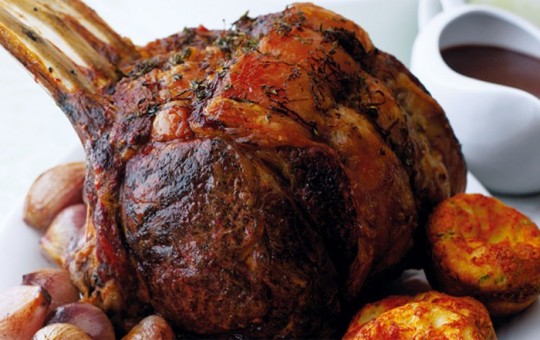
jQuery(document).ready(function() jQuery( "#tabs_" ).tabs( collapsible: true, active: false ); jQuery( ".scroller_" ).width(jQuery( ".scroller_" ).width()+1); //jQuery( ".scroller_" ).width('100%'); //jQuery( ".scroller_ ul" ).width('100%'); jQuery( "#tabs_" ).tabs( collapsible: false ); //var n = jQuery(".scroller_ ul li").length; //var w = (100/n-1); //jQuery(".scroller_ ul li").width(w+'%'); );
0 notes
Text
New Post has been published on Quieteating
New Post has been published on https://www.quieteating.com/st-johns-2/
St John Bread and Wine
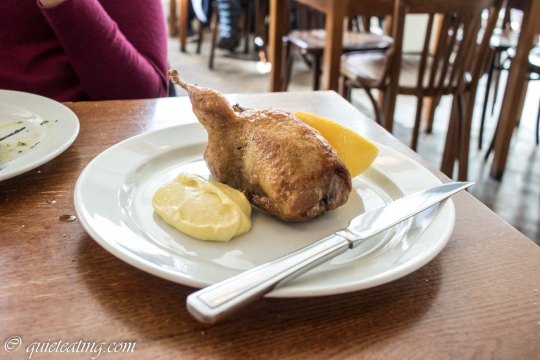
St John is known for starting the nose to tail eating revolution in the UK. People over here somehow seem to think it is a revolutionary new way to eat. Yet, I’m sure the peasants in the fields in Middle England could have told the modern urban diner something about eating off cuts. That’s what desperation does to you, be the mother of all invention. As otherwise they would be forced to scrounge around in the dust for subsistence. In a more up to date example, we (Chinese) people continue to do as our ancestors did. If it moves, or sometimes even if it doesn’t, it can be eaten. Think stewed chicken feet, monkey brain, tripe and of course twigs (bird’s nest). Maybe that’s just me but that’s why I like aquariums – so, so much food swimming around…
So this is how we ended up at St John with irrepressible hopes. Both of us were of oriental descent, so harboring unfulfilled dreams.
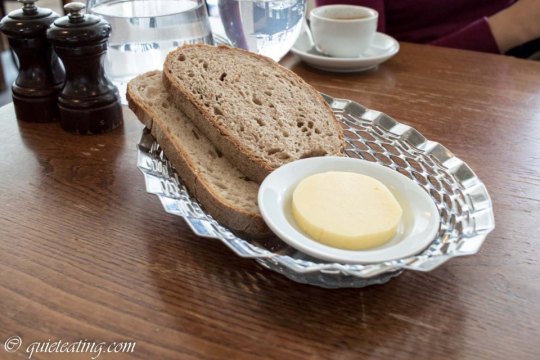
White and brown bread. First was something more mundane, bread and butter. The bread was excellent as we had expected. Moist, the right side of stodginess, not mired in the mud but rather just the right level of substance to take the creamy butter.

Kohlrabi, Brown shrimp and Chervil. With a very clean taste and particularly refreshing. A nice drop of cold water in the journey to banish the bad food memories I have had recently. Although I am not one for greens, this went down smoothly. Could have done with a little more shrimp though but otherwise not bad.
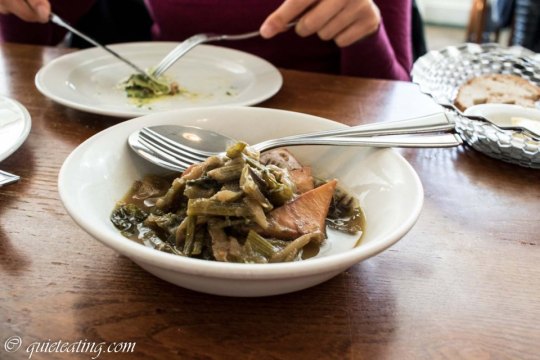
Braised Cuttlefish and Alexanders. Interesting. Savoury and sweet. An interesting texture. A salty and meaty texture from the Alexanders. A firmer touch to the cuttlefish. An unusual blend of flavours and textures that went together well.

Quail and aioli. Delicate, juicy and with a lovely aioli. The best example of quail that I have ever had. The bird was oh so very moist, unlike other quail I have had. The small bird seems to be oh too easily overcooked in other places I have tried. With the aioli it was magnificent. If there is a reason to come, this is definitely it.
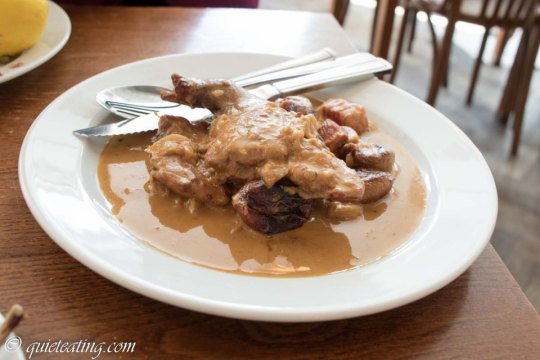
Braised Rabbit, Bacon, Mustard and Creme Fraiche. With such an encore, we had high hopes of the mains. This actually ended up as appetizing as it looked. This rabbit was a great contrast to the magnificent bird that had gone before. It was tough, dry and kind of bad. Best avoided.
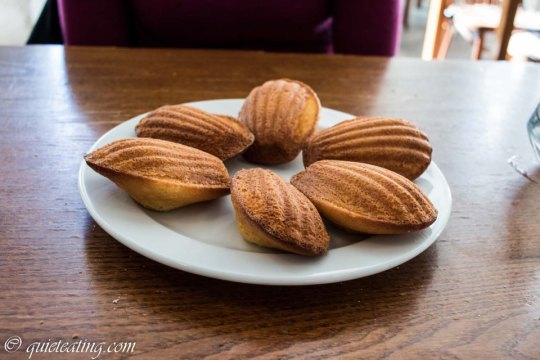
Madeleines. Justification for the name of St John Bread and Wine. Finishing on a high note, these madeleines were crispy on the outside, meltingly soft on the inside. These went a long way to banishing the disappointment of the rabbit.
So although we did not stray to the more esoteric cuts on offer, we did kind of enjoy ourselves. Even if some of the dishes were a bit hit and miss, they have to be applauded for going out on a limb. It’s not everywhere that you are offered duck’s heart, deviled kidneys and hokey pokey ice cream. Although we didn’t try any of these, maybe that’s a reason to return.
A quiet eating 6.5/10.
Lunch (3 courses) was GBP 30 excluding drinks and service.
St John Bread and Wine
Spitalfields Arts Market 94-96 Commercial St London E1 6LZ

0 notes